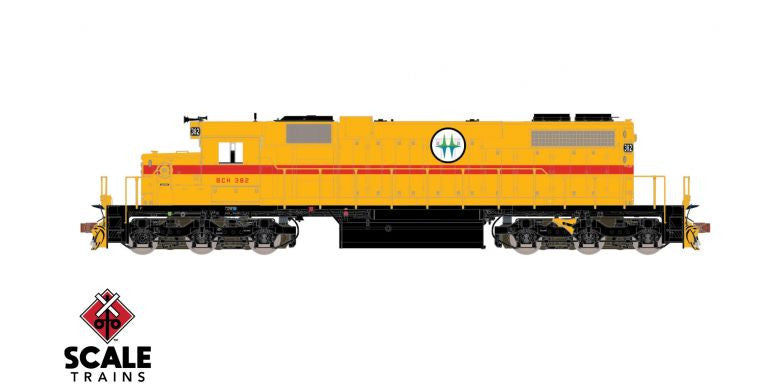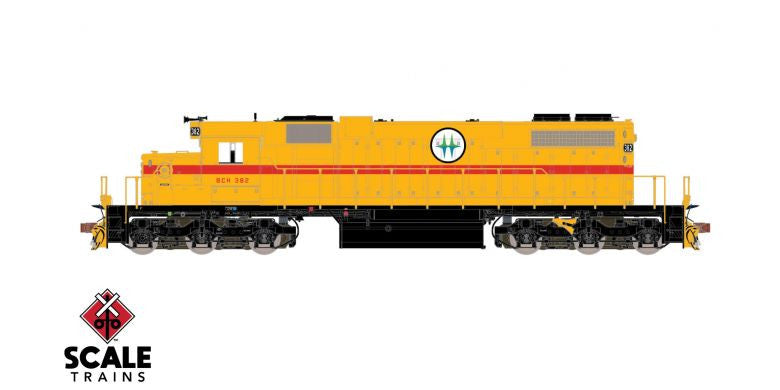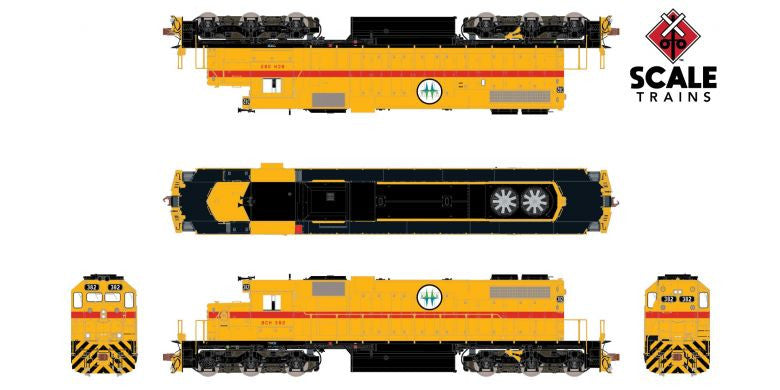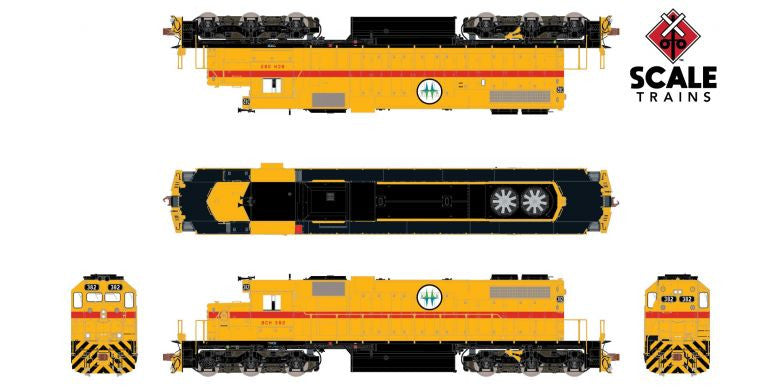Scaletrains SXT33111 EMD SD38-2, BC Hydro/As Delivered Yellow #382 - ESU v5.0 DCC and Sound HO Scale
Scaletrains SXT33111 EMD SD38-2, BC Hydro/As Delivered Yellow #382 - ESU v5.0 DCC and Sound HO Scale is backordered and will ship as soon as it is back in stock.
Couldn't load pickup availability
Description
Description
Scaletrains SXT33111 EMD SD38-2, BC Hydro/As Delivered Yellow #382 - ESU v5.0 DCC and Sound HO Scale. Picture may show a different road number.
Built by EMD from November of 1972 through June of 1979, the SD38-2 was essentially the six-axle version of the smaller GP38-2 that featured numerous electronic upgrades. Designed for slow, heavy-haul freight operations, EMD hoped that the higher tractive effort and electrical upgrades in -2 line would attract more buyers than the predecessor SD38, which only sold 53 units to North American railroads.
Unfortunately, the newer model fared only marginally better with a total of 90 units being sold worldwide. Although sales were less than anticipated, the SD38-2 proved to be a reliable workhorse with many of these locomotives remaining in hump yard or local service today.
The Rivet Counter™ series SD38-2 is the definitive HO Scale model of EMD’s unique non-turbocharged six-axle locomotive. Our model combines smooth operating performance with unparalleled railroad, road number, and era-specific details™. Not to mention, Rivet Counter models come equipped with industry-leading LED lighting features right out of the box.
Road Number Specific ScaleTrains
- Era: Early 1970s
- Series 382 to 383, built 12/72
- Road numbers 382 and 383
- Series 384 built 8/74
-
Road number 384 Fully-assembled
- 3,200-gallon fuel tank with fuel fillers, vertical gauge, round gauge in tank and angled breather pipe
- Multiple road numbers
- Operating LED ground lights on both sides of locomotive*
- Operating LED front and rear tricolor flush-mounted with raised gasket class lights**
- Printed and LED lighted number boards*
- Front and rear EMD-style low pilot plow with multiple unit (MU) hose doors and grab irons
- 3-hose multiple unit (MU) hose clusters with silver gladhands
- Semi-scale coupler buffer equipped with durable metal semi-scale Type E knuckle couplers
- Straight uncoupling levers with retrofitted switchman grab handles
- As-delivered pilot faces with no lifting slots
- Deck mounted multiple unit (MU) receptacle
- "Tall" stepwells with see-through steps
- Front and rear early small deck extension
- Handrail set with inward facing end rail mounting brackets and chain
- Standard front and rear drop steps
- Scale sectioned treadplate detail on walkways
- Rectangle walkway lights mounted between sandbox clean out doors (non-operating)
- 81” low short hood with wheel handbrake and left-hand side hot water cab heater louver vents
- Bolted battery box doors with narrow louvers
- Early cab sub-base doors with early hinges
- Standard EMD headlight in number board housing
- Dash 2 cab with 11-bolt (top and bottom) window panels and hot water heater louvers on right front
- Detailed cab interior with separate floor, rear wall, seats, and standard AAR control stand
- No cab vents
- Sliding cab side windows
- Tall clear wind wings mounted fore and aft of cab side window on right side of cab
- Home made cab sunshade right cab side only
- Lost wax brass cast Leslie Supertyfon RS-3L-R horn on number board housing
- Motorola ASP-16 “Firecracker” antenna mounted on the cab roof
- Accurate hood door and long hood detail
- Early electrical cabinet "zig-zag" seam, further from rear of cab
- Early “stand-off” ECAFB
- Intermediate inertial air intake grills with top drip rail
- Dual tall exhaust stacks
- Non-dynamic brake housing with batten strip
- See-through dynamic brake intakes with resistor grid detail
- Square PAF (Paper Air Filter) housing
- “Chicken-wire” radiator intake grilles
- See-through standard 48” radiator fan housings with fan blades visible inside
- Curved radiator fan grab iron
- Underbody frame rail with separate plumbing and traction motor cables
- Detailed HT-C trucks with Hyatt bearing caps, early center axle snubbers, sanding lines and brackets, and D-77 traction motor and air duct details
- Dimensionally accurate truck centers
- Speed recorder mounted to first axle left front
- Forward facing handbrake chain mount for Flexicoil trucks
- Tall jacking pads with holes (early)
- Aft engineer’s side sidesill notch
- Tab-mount EFCO
- Frame-mounted steel bell
- Salem air filter (accordion style)
- Factory-applied wire grab irons, wire lift rings, windshield wipers, trainline hoses with silver gladhands, sand hatch covers, and more
- Motor with 5-pole skew wound armature
- Dual flywheels
- All-wheel drive
- All-wheel electrical pick-up
- Directional LED headlights
- Printing and lettering legible even under magnification
- Operates on Code 70, 83 and 100 rail
- Packaging safely stores model
- Minimum radius: 18”
- Recommended radius: 22”
- DCC & sound equipped locomotives also feature
- ESU LokSound 5 DCC & Sound decoder with “Full Throttle”
- Two (2) cube-type speakers
- Non-Turbo EMD 16 Cylinder 645E3 prime mover
- ESU designed “PowerPak” with two super capacitors***
- Operates on both DC and DCC layouts
Following the success of the “1966-Line” of that same year, in January 1972 EMD was to give its product catalog a refresh, introducing what it dubbed the “Dash 2” line. Based upon customer feedback, EMD retained the basics of the previous 1966-Line, adding various improvements aimed at increasing reliability and performance. The Flexicoil-C truck used under the 1966-Line, its original iteration dating back to the SD7 of 1951, was replaced by a new truck design, called the HT-C, which offered greater adhesion, and was slightly longer than the Flexicoil-C. The frames of the six-axle Dash 2 units were lengthened slightly to accommodate the new truck design, and internally, all sported a new main electrical control cabinet featuring modular, solid-state components in the form of “cards” controlling various locomotive functions that could be pulled and replaced as needed, greatly simplifying the troubleshooting and repair process. The new models received a “-2” suffix, with the SD38 of 1966 being revised into the SD38-2.
Much like its SD38 predecessor, the SD38-2 was envisioned as a medium horsepower, high tractive effort machine, designed to haul heavy tonnage at relatively lower speeds. In contrast to its SD40-2 and SD45-2 brethren, which were optimized for hauling tonnage at higher speeds across all types of operating profiles, the SD38-2 was more at home lugging heavy commodity trains at low speed, or shuffling long cuts of cars in yards. While it wasn’t the ideal choice for blasting high-priority TOFC trains across the country, it would be right at home dragging a heavy iron-ore train up a 2% grade. Powered by the same basic 16-645 prime mover that drove the SD40-2, the SD38-2 lacked turbocharging, which kept its horsepower (HP) at 2,000, as opposed to the 3,000 of the 40-series.
The lower HP rating suited its intended duty just fine however, and the lack of a turbocharger simplified maintenance and reduced overall costs. Externally, the SD38-2 was very similar to the SD40-2, with the primary spotting features being a pair of radiator fans instead of the trio used on the SD40-2 (1,000 fewer HP didn’t require as much cooling), and it had a pair of small, oval stacks coming from its prime mover’s exhaust manifold instead of the single large rectangular stack coming from the turbocharger on the SD40-2. Lastly, the SD38-2 featured a large boxy housing on its roofline, just behind the inertial air filtration compartment, that housed groups of filter elements for engine combustion air.
While the overall number of SD38-2s built was but a tiny fraction of what EMD produced for the wildly popular SD40-2, the SD38-2 was sold to a wide variety of owners, representing most of the major carriers of the time during its production run from 1972 to 1979. Its performance characteristics were reflected in the roads that ordered them; Bessemer & Lake Erie and Elgin, Joliet & Eastern were tied for the most by an original owner, and utilized them in the heavy terminal switching and drag freight service those roads handled. At the other end of the service spectrum were roads like Chicago & North Western and Southern Pacific, which ordered SD38-2s for heavy yard switching and hump duty, already having plenty of higher-HP units on their rosters, like SD40-2s, for handling higher-speed road applications.
While not as prolific as other models in the catalog at the time, the SD38-2 served an important role for the roads that ordered them, and have had long careers, with many going on to new owners and paint schemes through sales and mergers. This new model from ScaleTrains is a logical addition to the product line, being an extension of the SD40-2 project, similar to how the prototype SD38-2 and SD40-2 were part of the same product line. Inside you’ll find the same smooth, proven mechanism as used in the SD40-2, and HT-C truck gearbox with “clasp” brake shoes, or standard brake shoes, per prototype. Square or angled paper air filter boxes are present, as are different dynamic brake and exhaust stack options. It also features all of the road-specific detailing you’ve come to expect on ScaleTrains models, down to the unique extended walkway ducts and raised rear walkway and slug electrical connections found on the SP units. These new units would be right at home on just about any layout, handling heavy switching and drag road duty, just like their 1:1 counterparts.
Specifications
Specifications
-
Scale
-
Product Type-
-
Height
-
Width
-
Depth








